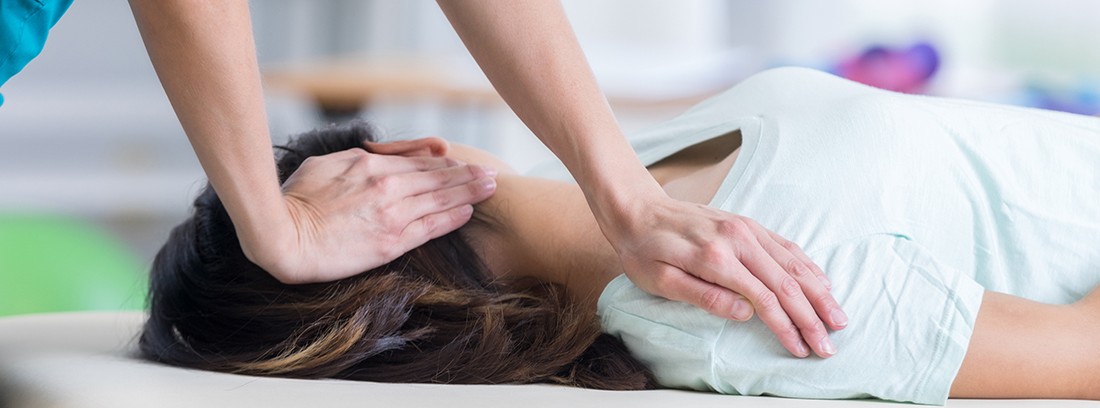Tension headache and physical therapy

It is underestimated since figuring out the exact cause that causes it can be somewhat complex and you do not receive adequate treatment. According to the World Health Organization (WHO) the one with a high prevalence. In addition, it is a disorder that usually causes a significant disability in the population, because it has a great impact on a health and socioeconomic level.
What are the possible causes of tension headache?
No direct cause has yet been determined leading to the headache However, there is research that indicates that the nociceptive mechanisms of the peripheral nervous system seem to be the main causes of the episodic tension headache and the chronic may be due to problems in sensitization processes of the central nervous system.
Stress, caffeine abuse, inappropriate eating, insomnia, or activities that force the head to be held in one position for a long time can cause a tension in the scalp, myofascial tissue and neck musculature that ultimately triggers a headache of tensional character. Also the weather conditions such as the cold, the position of the neck during rest or disorders of the temporomandibular joint can cause a sustained contraction of the cervical musculature and cause inflammation and pain.
Other possible causes
- Alcohol consumption
- Colds, flu, sinus infection.
- Bruxism (clenching the teeth).
- Eye strain.
- smoking
- Fatigue or overexertion.
Tension headache treatment
In addition to the pharmacological treatment that is usually prescribed for pain control, the most common treatment is through physical therapy, that is, physiotherapy. La offers a wide range of invasive and non-invasive therapies that can be used to treat this disorder:
- Cervical and dorsal musculature massage. The neck muscles contract due to maintained or forced positions, so the relaxation of the neck by kneading the muscles relaxes the muscle fibers.
- Myofascial therapy. It involves the treatment of active trigger points (tight bands of the muscle) in an invasive way with dry needling, or non-invasively with pressure on the skin. The goal is to relax the muscles and connective tissue (myofascial tissue). According to several studies, it is probably one of the most effective therapies because tension headache pain is correlated with trigger points.
- Stretching (trapezius muscles, levator scapulae, infraspinatus, splenium, sternocleidomastoid, etc.) Performing stretches assisted manually by the physio or autonomously at home is important both as treatment and prevention to maintain elastic muscles.
- Manipulative techniques. Often, due to muscle tension, the vertebrae can become blocked or compressed, also limiting the movement of the cervical spine. Cervical spine traction or joint unlocking helps restore normal joint movement.
- Local heat to activate circulation in the area and accelerate the tissue regeneration process.
- Electrotherapy. It is the application of electrodes on the skin with currents that relieve pain as a local anti-inflammatory.
How to prevent it
- Perform stretches of the cervical muscles. Tilt the head forward and to the sides, from the same position, also add a slight rotation to both sides. Hold for a few seconds until we notice that the muscle is giving way and help us with our hand to intensify the stretch.
- Self-massage with tennis ball or cane. Lying on the ground, place a ball or a cane just below the occiput (it is the first protrusion that we find in the back and lowest part of the skull). Next, the head should be moved from one side to the other, massaging the area and thus freeing the most insertional area.
- Perform physical exercise to keep the muscles active and elastic.
- Maintain a balanced diet. Consult with your GP or a nutritionist.
- Go to the physiotherapist. Do not wait until you have an ‘’ excruciating ’’ pain to go to the physio. In addition to treating you, it can help prevent that pain. If you have discomfort, so that the problem does not get worse.
- Avoid sustained postures for a long time, changing position during the day, especially during the work day.
- If you work in front of a computer, keep the screen at the level of our gaze to avoid sustained inclinations of the head.
- Sleeping with a pillow that prevents the head from tilting. The head and neck must be kept straight so that the muscles are at rest.
- A mattress that respects the physiological curvatures of the, neither too hard nor too soft.
- Do Pilates, yoga, dance, etc.. This type of exercise helps us to have a greater awareness of our body scheme.
- Physical therapy offers a wide range of invasive and non-invasive therapies that can be used to treat this disorder.
- According to several studies, myofascial therapy is likely to be one of the most effective because tension headache pain correlates with trigger points.
- The main objective of the different techniques is to lower muscle tone and reduce pain. An improvement of the circulatory and lymphatic system is also obtained, and therefore, the well-being of the patient.
(Updated at Apr 14 / 2024)